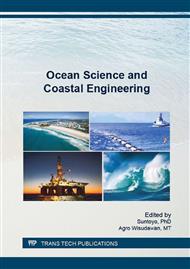p.284
p.291
p.296
p.302
p.308
p.315
p.321
p.326
p.332
Effect of Underwater Welding in Marine Environment and Surface Welding to Mechanical Properties of Steel Weld Joint
Abstract:
The offshore structure gradually will get damage. A number of offshore structure maintenance method require underwater working. Because of that, underwater welding become an importance thing. Through this research,will be assessed on changes in mechanical properties of steel weld joint in marine environmental. With same weld parameter, welding process also do in freshwater and on land for comparisonvariable. Welding process do in 0.2m depth with SMAW wet welding method on 1G position using AWS E6013 electrode coated with wax. After doing research, it is found that the tensile strength of welds in the marine environment is a little larger than the tensile strength in freshwater and on land, ie 49.44 kgf/mm2> 49.41 kgf/mm2 > 48.99 kgf/mm2. Hardness index value of welded steel in the marine environment is also higher than the value of the weld hardness results in freshwater and on land, in the amount of 195.37Hv10>181.13Hv10>153.6Hv10. The value of tensile strength and hardness values in the marine environment welds slightly larger than in freshwater due to the amount of grain mertensit phase. Ductility properties of the weld results in the marine environmentis smaller than the weld results in freshwater and land, it is characterized by a decline inelongation and reduction of area in underwater welding. From the observation of metallographic microstructure underwater welding it appears that phase grains coarser than the microstructure of welding on land. This can happen because the weld metal suffered liquefaction then freezes so quickly that opportunity grain experiencing severe grain growth during thawing did not get transformed into finer grains, so that the material is harder but brittle.
Info:
Periodical:
Pages:
308-314
Citation:
Online since:
January 2017
Authors:
Price:
Сopyright:
© 2017 Trans Tech Publications Ltd. All Rights Reserved
Share:
Citation:


